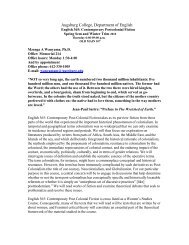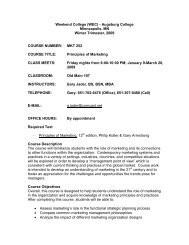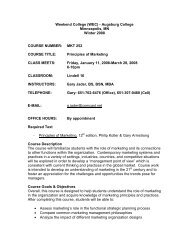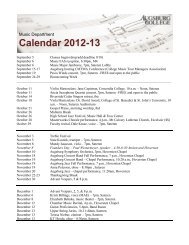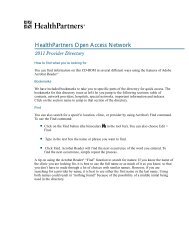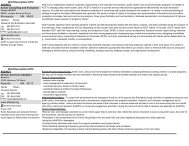- Page 2 and 3: CHALLENGE MATH FOR 5TH GRADERS, FIR
- Page 4 and 5: 4 Table of Contents An Introduction
- Page 7 and 8: An Introduction Hi and Welcome! Hi!
- Page 9 and 10: Gender and Multiculturalism in Math
- Page 11 and 12: this year. For less competitive rec
- Page 13: The name of this lesson’s unit go
- Page 17 and 18: Lesson #1: Introduction to Triangle
- Page 19 and 20: Geometry: A Shapely Approach to Mat
- Page 21 and 22: Notes: Geometry: A Shapely Approach
- Page 23 and 24: • • • • Geometry: A Shapely
- Page 25 and 26: Notes: Geometry: A Shapely Approach
- Page 27 and 28: Geometry: A Shapely Approach to Mat
- Page 29 and 30: Supplement 1: Pre-made Triangles Ge
- Page 31 and 32: Notes: Geometry: A Shapely Approach
- Page 33 and 34: Geometry: A Shapely Approach to Mat
- Page 35 and 36: Lesson #5: Pythagorean Triples Appr
- Page 37 and 38: Here are some more examples of how
- Page 39 and 40: Lesson #6: Pythagorean Proofs Appro
- Page 41 and 42: Geometry: A Shapely Approach to Mat
- Page 43 and 44: Geometry: A Shapely Approach to Mat
- Page 45 and 46: Lesson Objectives: • Learn how to
- Page 47 and 48: Geometry: A Shapely Approach to Mat
- Page 49 and 50: Notes: Geometry: A Shapely Approach
- Page 51 and 52: Lesson #8: Combinations Approximate
- Page 53 and 54: Notes: Probability: What are the Ch
- Page 55 and 56: Probability: What are the Chances?!
- Page 57 and 58: Notes: Probability: What are the Ch
- Page 59 and 60: Further Reading: • http://en.wiki
- Page 61 and 62: Lesson #11: Coins, Dice, and Playin
- Page 63 and 64: Probability: What are the Chances?!
- Page 65 and 66:
Lesson #12: The Monty Hall Problem
- Page 67 and 68:
Probability: What are the Chances?!
- Page 69 and 70:
Estimation and Approximation 69
- Page 71 and 72:
Estimation and Approximation slight
- Page 73 and 74:
Estimation and Approximation Lesson
- Page 75 and 76:
Estimation and Approximation How ca
- Page 77 and 78:
Combinatorics: How Many Ways Can Yo
- Page 79 and 80:
Combinatorics: How Many Ways Can Yo
- Page 81 and 82:
Notes: Combinatorics: How Many Ways
- Page 83 and 84:
Combinatorics: How Many Ways Can Yo
- Page 85 and 86:
Lesson #17: Cracking the Postal Cod
- Page 87 and 88:
Supplement 1 Combinatorics: How Man
- Page 89 and 90:
Lesson #18: The Catalan Numbers App
- Page 91 and 92:
Supplement 1: Parents’ Guide Comb
- Page 93 and 94:
Supplement 1: Parents’ Guide Comb
- Page 95 and 96:
Again and Again and Again... 95
- Page 97 and 98:
Again and Again and Again... Iterat
- Page 99 and 100:
Again and Again and Again... So how
- Page 101 and 102:
Again and Again and Again... You ma
- Page 103 and 104:
Notes: Again and Again and Again...
- Page 105 and 106:
Again and Again and Again... number
- Page 107 and 108:
ship. The most famous example of a
- Page 109 and 110:
Supplement 2: Grids and Initial Con
- Page 111 and 112:
Algebra: Solve for X 111
- Page 113 and 114:
Algebra: Solve for X Each of these
- Page 115 and 116:
Algebra: Solve for X same thing as
- Page 117 and 118:
Algebra: Solve for X Lesson #22: So
- Page 119 and 120:
Part 3: Square Roots and Exponents
- Page 121 and 122:
Supplement 1: Addition and Subtract
- Page 123 and 124:
Supplement 3: Square Roots and Expo
- Page 125 and 126:
Supplement 5: Teacher Answer Key 1)
- Page 127 and 128:
Lesson #23: Puzzle Worksheets Appro
- Page 129 and 130:
Supplement 2: Solution Sheet 1 2 3
- Page 131 and 132:
Supplement 4: Worksheet 2 Algebra P
- Page 133 and 134:
Supplement 6: Worksheet 4 Algebra P
- Page 135 and 136:
Supplement 8: Worksheet 6 Algebra P
- Page 137 and 138:
Notes: Algebra: Solve for X 137
- Page 139 and 140:
Lesson Objectives: • Understand p
- Page 141 and 142:
Graphing: Plot the Points say that
- Page 143 and 144:
Notes: Graphing: Plot the Points 14
- Page 145 and 146:
Part 2: Graph It Further Reading:
- Page 147 and 148:
Notes: Graphing: Plot the Points 14
- Page 149 and 150:
Graphing: Plot the Points For an ad
- Page 151 and 152:
Notes: Graphing: Plot the Points 15
- Page 153 and 154:
Graphing: Plot the Points your stud
- Page 155 and 156:
Supplement 1: Graph Paper Graphing:
- Page 157 and 158:
Lesson #28: Manipulating Graphs App
- Page 159 and 160:
f(x) = -x 2 f(x) = -x 3 Notice that
- Page 161 and 162:
Notes: Graphing: Plot the Points 16
- Page 163 and 164:
Lesson #29: Set Basics Approximate
- Page 165 and 166:
Part 2: Tying the sets together Fur
- Page 167 and 168:
Lesson #30: Infinite Sets and Greek
- Page 169 and 170:
Notes: An Introduction to Sets 169
- Page 171 and 172:
The Story of the HOTEL AD INFINITUM
- Page 173 and 174:
An Introduction to Sets Well, in on
- Page 175 and 176:
Fun with Numbers 175
- Page 177 and 178:
Part 2: Multiplication Further Read
- Page 179 and 180:
Lesson #33: Introduction to Sequenc
- Page 181 and 182:
Fun with Numbers Ask the question:
- Page 183 and 184:
Lesson Objectives: • Find pattern
- Page 185 and 186:
Fun with Numbers draw a number line
- Page 187 and 188:
Lesson #35: Fun with the Fibonacci
- Page 189 and 190:
Part 2: The Golden Rectangle Fun wi
- Page 191 and 192:
Further Reading: • http://www.mcs
- Page 193 and 194:
Supplement 2: Golden Rectangle Fun
- Page 195 and 196:
Notes: Fun with Numbers 195
- Page 197 and 198:
Fun with Numbers What do you notice
- Page 199 and 200:
Supplement 2: Da Vinci’s Vitruvia
- Page 201 and 202:
Lesson #37: Prime Numbers and the U
- Page 203 and 204:
Fun with Numbers Once each group ha
- Page 205 and 206:
Supplement 1: 399 x 399 Ulam Spiral
- Page 207 and 208:
Different Bases: Beyond Base 10 207
- Page 209 and 210:
Part 1: Draw a computer Different B
- Page 211 and 212:
Notes: Different Bases: Beyond Base
- Page 213 and 214:
Different Bases: Beyond Base 10 bas
- Page 215 and 216:
Lesson #40: Exploding Dots Approxim
- Page 217 and 218:
3 6 = 279 3 5 = 243 3 4 = 81 3 3 =
- Page 219 and 220:
Supplement 1 How can you count the
- Page 221 and 222:
Lesson #41: Jeopardy Approximate le
- Page 223 and 224:
Notes: Different Bases: Beyond Base
- Page 225 and 226:
Lesson #42: The Four Color Theorem
- Page 227 and 228:
Connecting Dots and Coloring Graphs
- Page 229 and 230:
7. Use that third color to fill in
- Page 231 and 232:
Supplement 1: U.S. Map Connecting D
- Page 233 and 234:
Supplement 3: More Maps Connecting
- Page 235 and 236:
Notes: Connecting Dots and Coloring
- Page 237 and 238:
Connecting Dots and Coloring Graphs
- Page 239 and 240:
Notes: Connecting Dots and Coloring
- Page 241 and 242:
Connecting Dots and Coloring Graphs
- Page 243 and 244:
Connecting Dots and Coloring Graphs
- Page 245 and 246:
Notes: Connecting Dots and Coloring
- Page 247 and 248:
Lesson #45: Playdough and Mobius St
- Page 249 and 250:
Further Reading: • http://en.wiki
- Page 251 and 252:
Lesson #46: Euler Number Approximat
- Page 253 and 254:
Topology: Coffee Cups and Doughnuts
- Page 255 and 256:
Supplement 1 (cont’d): Cut-outs T
- Page 257 and 258:
Thinking Puzzles 257
- Page 259 and 260:
Thinking Puzzles ber, and you can i
- Page 261 and 262:
Notes: Thinking Puzzles 261
- Page 263 and 264:
Thinking Puzzles Yet the 8 is in th
- Page 265 and 266:
Lesson #49: Secret Code Approximate
- Page 267 and 268:
Thinking Puzzles Depending on how f
- Page 269 and 270:
Thinking Puzzles Lesson #50: Playin
- Page 271 and 272:
Supplement 1: Student Worksheet Log
- Page 273 and 274:
Space Fillers and Mathematical Game
- Page 275 and 276:
3-D Tic-Tac-Toe Space Fillers and M
- Page 277 and 278:
Crypto Space Fillers and Mathematic
- Page 279 and 280:
Actue Used to describe an angle les
- Page 281 and 282:
Circle A two-dimensional figure cre
- Page 283 and 284:
Eulerian path A graph has an Euleri
- Page 285 and 286:
Glossary Infinite sequence An infin
- Page 287 and 288:
Glossary Phi (Pronounced ‘fee’
- Page 289 and 290:
though both contain the exact same
- Page 291:
With replacement In probability, wh



